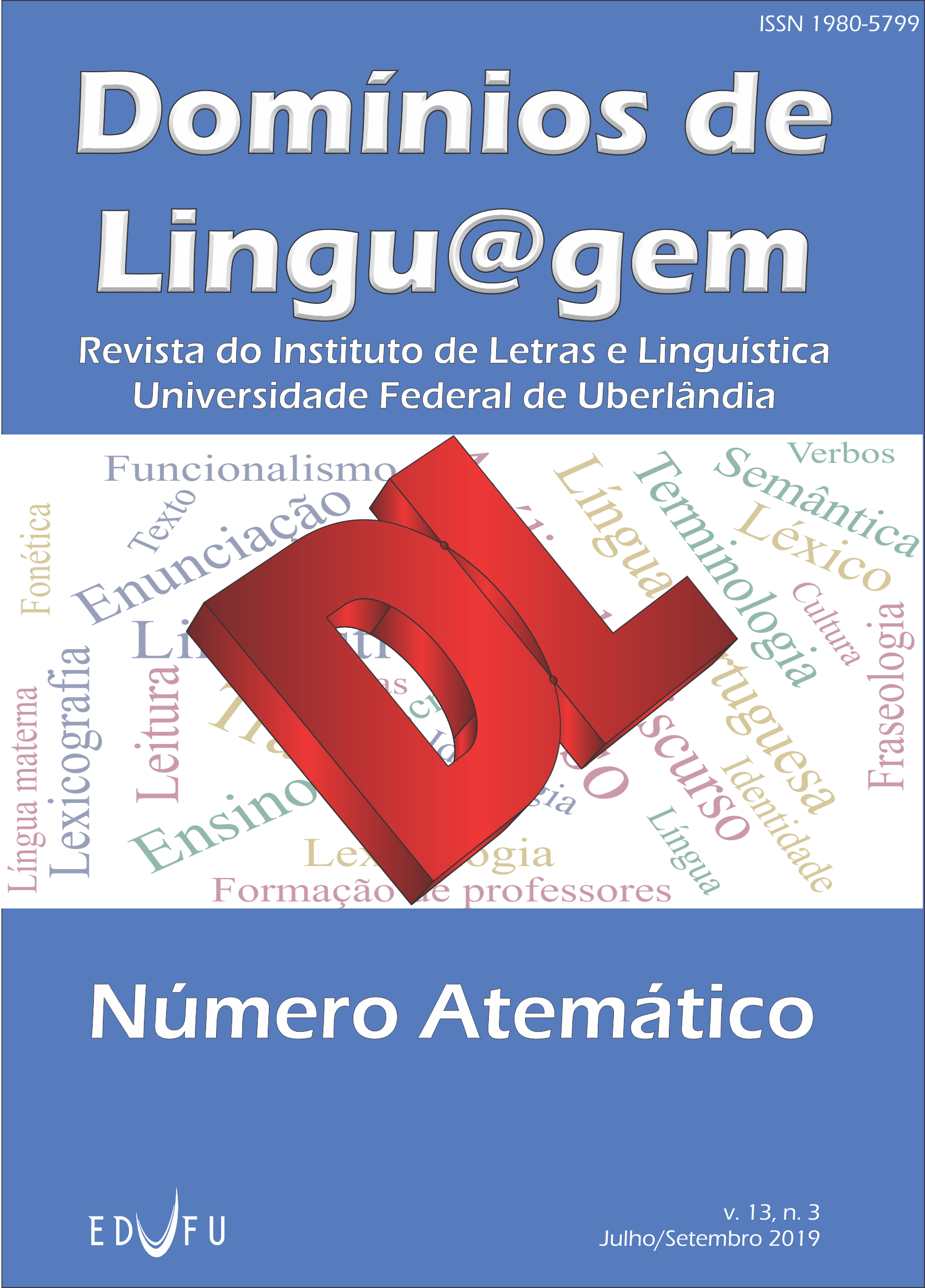Cláusulas relativas na fala espontânea
estrutura informacional e processos de subordinação
DOI:
https://doi.org/10.14393/DL39-v13n3a2019-6Palavras-chave:
Cláusulas Relativas, Fala espontânea, Teoria da Língua em Ato, Funcionalismo, Linguística de CorpusResumo
Este artigo discute a relação entre estrutura informacional e processos de subordinação das cláusulas relativas da fala espontânea do português brasi-leiro (PB). A base teórica vem da Language into Act Theory (CRESTI, 2000) e da linguística funcionalista (HOPPER; TRAUGOTT, 1993; CRISTOFARO, 2003; RODRIGUES, 2015, 2014). Nesse comtex-to, foi utilizada uma amostra balanceada do C-ORAL BRASIL (RASO; MELLO, 2012), etiquetada informacionalmente. Os resultados demonstram que a forma sintática [...N [QUE + verbo finito...]SAdj]SN, que corresponde às cláusulas relativas, ocorrem em dois contextos informa-cionais distintos: o linearizado e o pa-dronizado. Contudo, no primeiro, a cláusula ocorre subordinada e insubor-dinada dentro da unidade informacional; no último, justaposta sintaticamente em mais de uma unidade informacional.
Downloads
Referências
BECHARA, E. Moderna gramática portuguesa. 37 ed. Rio de Janeiro: Lucerna, 2004.
BERBER SARDINHA, T. A. Linguística de corpus. São Paulo: Manole, 2004.
BOSSAGLIA, G. Orientação pragmática da sintaxe na fala: uma análise corpus-based da subordinação completiva e adverbial no português do Brasil. Domínios de Lingu@gem, v. 9, n. 5 (dez. 2015), p. 309-335, 2015. DOI https://doi.org/10.14393/dle-v9n5a2015-16. Disponível em: http://www.seer.ufu.br/index.php/dominiosdelinguagem/article/view/29246. Acesso em: 15 jul. 2016.
CARMO, C. B. S.; MELLO, H. Cláusulas relativas na fala espontânea do português do Brasil: um estudo exploratório baseado no corpus C-ORAL-BRASIL. Signun: Estudos da Linguagem. v. 19, n. 2, p. 342-367, dez. 2016a. DOI https://doi.org/10.5433/2237-4876.2016v19n2p342. Disponível em: http://www.uel.br/revistas/uel/index.php/signum/article/view/25097. Acesso em: 20 mar. 2018.
CARMO, C. B. S. Relative Clauses in spontaneous speech: a definition based on the Language into Act Theory. Fórum Linguistico, Florianópolis, v.14, n. 2, p. 61-75, abr./jun. 2017b. Disponível em: https://periodicos.ufsc.br/index.php/forum/article/view/1984-8412.2017v14n2p2061. Acesso em: 20 mar. 2018.
CARMO, C. B. S. A complexidade das cláusulas relativas na fala espontânea do português do Brasil: os dados do C - ORAL Brasil. 2017c, 206 f. Tese (Doutorado em Esudos Linguísticos). Programa de Pós-Graduação em Estudos Linguísticos, Faculdade de Letras, Universidade Federal de Minas Gerais, Belo Horizonte, 2017. DOI https://doi.org/10.24873/j.rpemd.2018.11.236.
CINTRA, L.; CUNHA, C. Nova gramática do português contemporâneo. 3. ed. Rio de Janeiro: Nova Fronteira, 2001.
CRESTI, E. Corpus di Italiano parlato. Firenze: Accademia della Crusca, 2000.
CRESTI, E. Syntactic properties of spontaneous speech in the language into act theory: data on italian complements and relative clauses. In: RASO, T.; MELLO, H. (org.). Spoken corpora and linguistic studies: Problems and perspectives. Amsterdam/Philadelphia: John Benjamins, 2014. p. 365-410. DOI https://doi.org/10.1075/scl.61.13cre.
CRESTI, E; MONEGLIA, M. (ed.). C-ORAL-ROM: integrated reference corpora for spoken romance languages. Amsterdam/Philadelphia: John Benjamins, 2005. DOI https://doi.org/10.1075/scl.15.
CRISTOFARO, S. Subordination. Oxford: University Press, 2003.
EVANS, N. Insubordination and its uses. In: NIKOLAEVA, I. Finiteness: Theoretical and Empirical Foundations. Oxford: Oxford University Press, 2007. p. 366‐431.
GREGORI, L.; PANUNZI, A. DB-IPIC: an XML database for the representation of information structure in spoken language. In: MELLO, H.; PANUNZI, A.; RASO, T. (ed.). Pragmatics and prosody: illocution, modality, attitude, information patterning and speech annotation. Firenze: Firenze University Press, 2011. p. 133-149.
HARDIE, A.; McENERY, T. Corpus linguistics. Cambridge: University Press, 2002.
HART, J.; COLLIER, R.; COHEN, A. A perceptual study on intonation: an experimental approach to speech melody. Cambridge: CUP, 1990. DOI https://doi.org/10.1017/cbo9780511627743.
HOPPER, P. J.; TRAUGOTT, E. C. Grammaticalization. Cambridge: Cambridge University Press, 1993.
MELLO, H; BOSSAGLIA, G; RASO, T. Syntactic phenomena in light of prosodyoriented segmentation in spoken Brazilian Portuguesese: estudo apresentado na 8es Jounées Internationales de Linguístique de Corpus. Orleans/FRA, 2 a 4 de setembro de 2015.
NENCIONE, G. Di scritto e di parlato: Discorsi linguistici. Bologna: Zanichelli, 1983.
RASO, T. Fala e escrita: meio, canal, consequências pragmáticas e linguísticas. Domínios de Lingu@gem, v. 7, p. 12-46, 2013. DOI https://doi.org/10.14393/dl14-v7n2a2013-3. Disponível em: http://www.seer.ufu.br/index.php/dominiosdelinguagem/article/view/23730. Acesso em: 20 mar. 2018.
RASO, T; MELLO, H. (org). C-ORAL-BRASIL I: Corpus de referência do português brasileiro falado informal. Belo Horizonte: Editora UFMG, 2012.
ROCHA LIMA. Gramática Normativa da Língua Portuguesa. 31. ed. [1a impr.]. Rio de Janeiro: José Olympio, 1992.
RODRIGUES, V.V. Comprou, levou? Justaposição: procedimento sintático comum em propagandas. Revista Letrônica / Revista Digital do Programa de Pós-Graduação em Letras da PUCRS. Porto Alegre, v. 8, n. 2. p. 409-421, 2015. DOI https://doi.org/10.15448/1984-4301.2015.2.20348. Disponível em: http://revistaseletronicas.pucrs.br/ojs/index.php/letronica/ Acesso em: 20 mar. 2018.
RODRIGUES, V. V. Em foco a correlação. Revista Diadorim: Revista de Estudos Linguísticos e Literários, Programa de Pós-Graduação em Letras Vernáculas da Universidade Federal do Rio de Janeiro, Rio de Janeiro, v. 16, p. 122-139, dez. 2014. DOI https://doi.org/10.35520/diadorim.2014.v16n0a4028. Disponível em: https://revistas.ufrj.br/index.php/diadorim/article/view/4028/3006. Acesso em: 20 mar. 2018.
Downloads
Publicado
Edição
Seção
Licença
Autores que publicam nesta revista concordam com os seguintes termos da licença Creative Commons
CC BY-NC-ND 4.0: o artigo pode ser copiado e redistribuído em qualquer suporte ou formato; os créditos devem ser dados ao autor original e mudanças no texto devem ser indicadas; o artigo não pode ser usado para fins comerciais; caso o artigo seja remixado, transformado ou algo novo for criado a partir dele, o mesmo não pode ser distribuído.
Autores têm autorização para assumir contratos adicionais separadamente, para distribuição não-exclusiva da versão do trabalho publicada nesta revista (ex.: publicar em repositório institucional ou como capítulo de livro), com reconhecimento de autoria e publicação inicial nesta revista.









